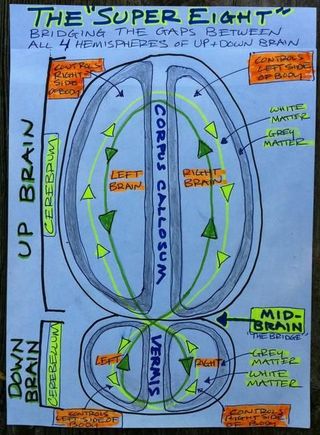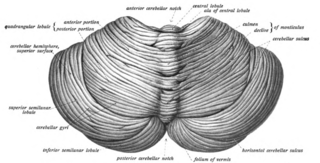Neuroscience
Harvard Research Shows How the Cerebellum Regulates Thoughts
The cerebellum is responsible for monitoring both motor and non-motor functions.
Posted May 21, 2016

In 1504, Leonardo da Vinci made wax castings of the human brain and coined the term cerebellum (Latin for “little brain”) to describe two small brain hemispheres that are neatly tucked under the relatively colossal hemispheres of the cerebrum (Latin for “brain") which houses the cerebral cortex. (Cerebellar is the sister word to cerebral and means, "relating to, or located in the cerebellum.")
Historically, neuroscientists have considered the cerebellum to be the seat of non-thinking motor activities such as coordinating and fine-tuning muscle movements. However, in recent years, a wide range of studies have found that the cerebellum plays a fundamental role in many of our cognitive, emotional, and creative processes. Now, visionaries at Harvard Medical School have shown (for the first time) how the cerebellum fine-tunes our thoughts, just as it fine-tunes our movements.
"Whatever the Cerebellum Is Doing, It's Doing a Lot of It."

As an athlete and coach, I've always been fascinated with the connection between both hemispheres of the cerebellum and both hemispheres of the cerebrum in terms of optimizing both athletic mindset and sports performance.
In 2007, when I published The Athlete's Way (St. Martin's Press), I presented a novel split-brain model that seated explicit memory and learning in the cerebrum, and unconscious and implicit learning in the cerebellum. I coined this model "up brain-down brain" as a direct and cogent response to "left brain-right brain."
Throughout the process of writing my first book, I consulted daily with my father, Richard M. Bergland, who was a neuroscientist, neurosurgeon, and author of The Fabric of Mind (Viking). My dad firmly believed that the cerebellum was more than just the seat of muscle memory and motor skills. He was obsessed with the cerebellum and passed this obsession on to me. Together, my father and I created the "Bergland split-brain model" also known as "up brain-down brain."
The cerebellum is only 10% of brain volume but holds almost 80% of your brain's total neurons. Conversely, the cerebrum is 90% of brain volume but only holds approximately 20% of your brain's total neurons. Based on this disproportionate distribution of neurons, my father would often say, "We don't know exactly what the cerebellum is doing, but whatever it's doing, it's doing a lot of it."

Immediately after publishing The Athlete's Way, my ideas about the cerebellum were flat out rejected by the medical establishment. I was labeled by many thought leaders and experts in the field as a "dumb jock" who didn't have a clue about neuroscience. Just about everyone thought my trailblazing hypotheses about the cerebellum were crazy a decade ago... and my book was an unmitigated commercial flop.
The criticism and rejection I experienced after my first book was published bruised my ego. My empathetic and wise editor, Diane Reverand, tamed my wild disappointment by saying, "Chris, your ideas were just ahead of their time. The world wasn't ready, yet. Be patient. Wait ten years, and the mainstream establishment will catch up."
I must admit, I felt slightly vindicated to wake up this morning and read cutting-edge news from a recent neuroscience conference in Vancouver, BC, Canada about new discoveries on the role that the cerebellum plays in cognition. I have a hunch that neuroscience is on the verge of a revolution that may have profound impacts on psychiatry based on these groundbreaking new understandings of the cerebellum.
This year at the 2016 American Academy of Neurology annual Frontiers in Neuroscience Plenary, Jeremy D. Schmahmann, MD, professor of neurology at Harvard Medical School and director of the Massachusetts General Hospital (MGH) ataxia unit, gave a lecture on the role that the cerebellum plays in human cognition.
In his lecture, “The Cerebellar Cognitive Affective Syndrome: Implications for Neurology and Psychiatry,” Schmahmann stated, “The cerebellum regulates thought just as importantly as it regulates movements.” This is a revolutionary concept.
The Cerebellum Regulates and Fine-Tunes Our Thoughts

After decades of studying ataxia at MGH, Dr. Jeremy Schmahmann has developed a hypothesis that, "just as the motor portions of the cerebellum regulate the speed, capacity, and appropriateness of movements, the posterior cerebellum regulates these same features of thought."
Schmahmann developed this theory after studying multiple patients with damage to the cerebellum and observing a pattern of deficits in the cognitive domains of executive function, spatial cognition, and language.
This syndrome—first observed by Dr. Jeremy Schmahmann and his colleagues at MGH—was coined Cerebellar Cognitive Affective Syndrome (CCAS). It is also called "Schmahmann's syndrome” which is represented by impairments of executive function that include: 'problems with planning, set-shifting, abstract reasoning, verbal fluency, and working memory.' There is often 'perseveration, distractibility and inattention’ correlated with lesions (damage) to the cerebellum.

Damage to the cerebellum is also associated with deficits in spatial cognition, visual-spatial disorganization, and impaired visual-spatial memory; as well as, language problems and mild anomia. Additionally, Schmahmann has observed personality changes in patients with cerebellar damage which manifest as 'blunting of affect or disinhibited and inappropriate behavior.' These cognitive impairments caused by damage to the cerebellum often result in an overall lowering of intellectual function.
The discovery of CCAS is revolutionary because it challenges the traditional view that the cerebellum is solely responsible for regulating our motor functions. It is now believed that the cerebellum is responsible for monitoring both motor and non-motor functions.
The non-motor deficits observed in CCAS are believed to be caused by abnormalities in the functional connectivity of the cerebellum with the cerebral cortex. More specifically, connection mapping by Schmahmann et al. has revealed extensive circuits linking the posterior cerebellum to multiple cortical regions, including the prefrontal cortex.
Conclusion: The Posterior Cerebellum Makes Us Human
Just as neuroscientists pinpointed the role of various lobes in the cerebrum during the 20th century, it appears to me that the next frontier in neuroscience during the 21st century will be to map how various ‘micro-zones’ in each cerebellar hemisphere interact with specific brain areas in the left and right hemispheres of the cerebrum. This is just an educated guess on my part...
However, based on the recent presentation by Dr. Schmahmann, I believe that the posterior cerebellum could take center stage in the years ahead based on its significant role in our human evolution. As Schmahmann explains, “The posterior lobe has expanded massively in evolution. Only the prefrontal cortex has grown more than the cerebellum during human evolution."
In a statement, Stefan Pulst, MD, PhD, FAAN, an expert in cerebellar ataxias at the University of Utah in Salt Lake City and head of Pulst Laboratory, said,
“As Dr. Schmahmann has emphasized, it is the ‘human’ portion of the cerebellum that has expanded the most. That the circuitry of the cerebellum is used by multiple systems in the brain, not just the motor system, makes Dr. Schmahmann's concept of ‘dysmetria of thought’ so important.”
In closing, here's a YouTube video of Jeremy Schmahmann explaining his concept of 'Dysmetria of Thought' which describes how the cerebellum fine-tunes our thoughts, just as it fine-tunes our movements. Stay tuned for more on this exciting topic!
To read more on the cerebellum, check out my Psychology Today blog posts,
- "5 Reasons the Cerebellum Is Key to Thriving in a Digital Age"
- "The Cerebellum Deeply Influences Our Thoughts and Emotions"
- "The Cerebellum May Be the Seat of Creativity"
- "How Are Digital Devices Changing the Way We Think?"
- "Why Does Overthinking Cause Athletes to Choke?"
- "Why Does Overthinking Sabotage the Creative Process?"
- "Eureka! Deconstructing the Brain Mechanics of Aha! Moments"
- "Cerebellum Damage May Be the Root of PTSD in Combat Veterans"
- "The Neuroscience of Calming a Baby"
- "More Research Links Autism and the Cerebellum"
- "Too Much Crystallized Thinking Lowers Fluid Intelligence"
- "How Do Motor Regions of the Brain Drive Fluid Intelligence?"
- "Aha! Aerobic Exercise Facilitates the Free Flow of Thought"
- "Superfluidity: Decoding the Enigma of Cognitive Flexibility"
© 2016 Christopher Bergland. All rights reserved.
Follow me on Twitter @ckbergland for updates on The Athlete’s Way blog posts.
The Athlete’s Way ® is a registered trademark of Christopher Bergland.




